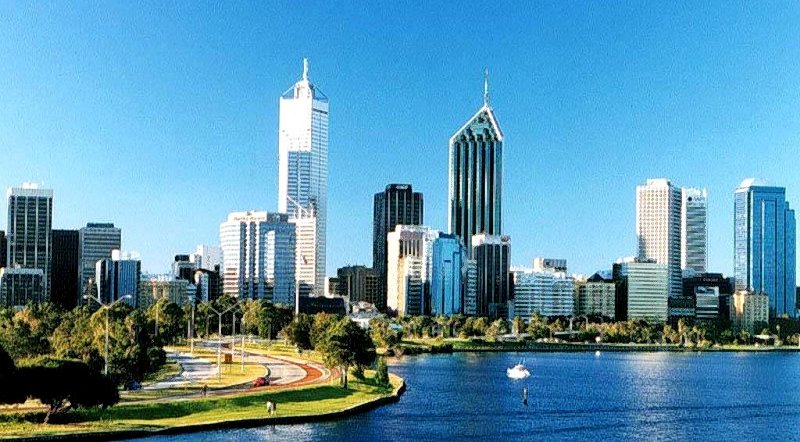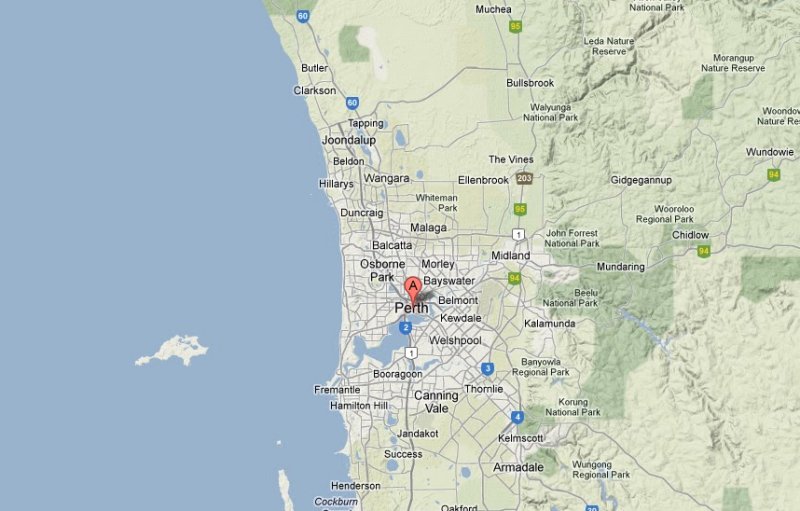
The city of Perth in Western Australia was named by Captain James Stirling in 1829 after Perth, Scotland, in honor of the birthplace and parliamentary seat in the British House of Commons of Sir George Murray, Secretary of State for War and the Colonies.
The first inhabitants of Australia arrived from the north approximately 40,000 to 60,000 years ago and eventually spread across the whole landmass. These Indigenous Australians were well established in the area around Perth by the time European ships started accidentally arriving en-route to Batavia (now Jakarta) in the early seventeenth century.
Before the establishment of the Swan River Colony, the indigenous Nyungar people occupied the southwest corner of Western Australia, hunting and gathering. The lakes on the coastal plain were particularly important to the Aboriginal people, providing them with both spiritual and physical sustenance.
The area in which Perth now stands was called Boorloo. Boorloo formed part of Mooro, the tribal lands of Yellagonga, whose group was one of several based around the Swan River, known collectively as the Whadjug. The Whadjug was a part of the greater group of 13 or so dialect groupings which formed the south west socio-linguistic block still known today as Nyungar (“The People”), or sometimes by the name Bibbulmun.
After settlement in 1829, the European settlers gave the name “Third Swamp” to one of a chain of wetland lakes stretching from Claisebrook to Herdsman Lake. Nearly seventy years later, in 1897, 15 hectares of Third Swamp would be gazetted as a public park and two years later renamed Hyde Park. Hyde Park is now one of Perth’s most attractive and popular parks.
From 1831, hostile encounters between European settlers and Nyungars – both large-scale land users with conflicting land value systems – increased considerably. This phase of violence culminated in events such as the execution of Whadjug tribal chief Midgegooroo, the murder of his son Yagan and the massacre of the Pindjarep people.
By 1843, when Yellagonga died, his tribe had begun to disintegrate and had been dispossessed of their land around the main settlement area of the Swan River Colony. They retreated to the swamps and lakes north of the settlement area including Third Swamp, formerly known by them as Boodjamooling.
Third Swamp continued to be a main campsite for the remaining Nyungar people in the Perth region and was also used by travellers, itinerants and homeless people. By the goldrush days in the 1890s they were joined by many miners en route to the goldfields. As Perth expanded with the gold rush the Nyungar people moved to Lake Gnangara where they were isolated from the European community until changes in the laws that recognised Aboriginal people during 1960s. The camp remained occupied until the early 1980s when it was converted to a school for Aboriginal children.
The first Europeans to sight the land where Perth is now located were the Dutch. Most likely the first visitor to the Swan River area was Frederick de Houtman on 19 July 1619, travelling on the ships Dordrecht and Amsterdam. His records indicate he first reached the Western Australian coast at latitude 32°20′ which would equate to Rottnest or just south of there. He did not land because of heavy surf, and so proceeded northwards without much investigation.
On 28 April 1656, the Vergulde Draeck (Gilt Dragon) en route to Batavia (now Jakarta) was shipwrecked only 107km north of the Swan River near Ledge Point. Of the 193 on board, only 75 made it to shore. A small boat that survived the wreckage then sailed to Batavia for help, but a subsequent search party found none of the survivors. The wreck was rediscovered in 1963.
In 1658, three ships, also partially searching for the Vergulde Draeck visited the area. The Waekende Boey under Captain S. Volckertszoon, the Elburg under Captain J. Peereboom and the Emeloort under Captain A. Joncke sighted Rottnest but did not proceed any closer to the mainland because of the many reefs. They then travelled north and subsequently found the wreck of the Vergulde Draeck (but still no survivors). They gave an unfavourable opinion of the area partly due to the dangerous reefs.
The Flemish captain Willem de Vlamingh was the next European in the area. Commanding three ships, the Geelvink, Nyptangh and the Wezeltje, he arrived at and named Rottnest on 29 December 1696, and on 10 January 1697 discovered and named the Swan River. His ships couldn’t sail up the river because of a sand bar at its mouth, so he sent out a sloop which even then required some dragging over the sand bar. They sailed until reaching mud flats probably near Heirisson Island. Vlamingh was also not impressed with the area.
In 1801, the French ships Geographe captained by Nicolas Baudin and Naturaliste captained by Baron Hamelin visited the area from the south. While the Geographe continued northwards, the Naturaliste remained for a few weeks. A small expedition dragged longboats over the sand bar and explored the Swan River. They also gave unfavourable descriptions regarding any potential settlement due to many mud flats upstream and the sand bar (the sand bar wasn’t removed until the 1890s when C. Y. O’Connor built Fremantle harbour).
Later in March 1803, the Geographe with another ship Casuarina passed by Rottnest on their way eventually back to France, but did not stop longer than a day or two.
The next visit to the area was the first Australian-born maritime explorer, Phillip Parker King in 1822 on the Bathurst. King was also the son of former Governor Philip Gidley King of New South Wales. However, King also was not impressed with the area. So, of all the early visitors to the Perth area, none had a favourable opinion.
The first explorer to have a favourable opinion of the Swan River was Captain James Stirling who, in March 1827, explored the area in HMS Success which first anchored off Rottnest, and later in Cockburn Sound. Stirling arrived back in England in July 1828, promoting in glowing terms the agricultural potential of the area. His lobbying was for the establishment of a “free settlement”, unlike the other penal settlements at New South Wales, Port Arthur and Norfolk Island. As a result of these reports, and a rumour the French were about to establish a penal colony in the western part of Australia, the Colonial Office assented to the proposal in mid-October 1828.
The first ship to reach the Swan River was the HMS Challenger captained by Charles Fremantle on 25 April 1829. After anchoring off Garden Island, Fremantle declared the Swan River Colony for Britain on 2 May 1829. The Parmelia under Captain Stirling arrived on 1 June, and the official foundation of the colony took place on 12 August, with the chopping down of a tree by wife of the captain of the Sulphur, Mrs Helen Dance. The two separate townsites of the colony developed slowly into Perth and the port city of Fremantle.
The fertile locations around Perth did not extend very far from the Swan and Canning Rivers and this land was quickly settled. The most fertile locations were upstream from Perth, and so the suburb of Guildford was also settled in 1829.
Much of the remaining land around the Swan River turned out to be quite sandy and unsuitable for agriculture and so the first reports of the colony were not as glowing as Stirling had been to suggest. These reports along with the difficulty of clearing land to grow crops was a factor in the initial slow growth of Perth during the first couple of decades. By 1850 the population of the whole colony had only increased to 5,886. Agriculture developed away from Perth in places like the Avon Valley and along the southwest coastline.
Perth was still seen as the administrative centre for the colony of Western Australia though.


